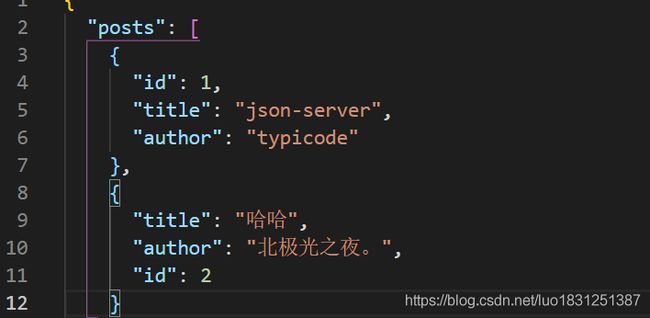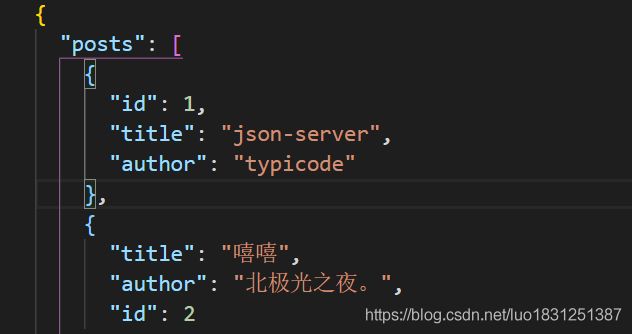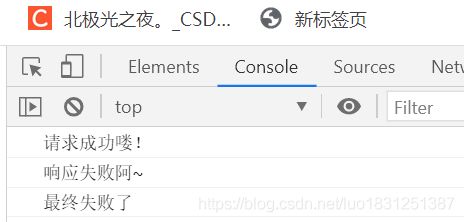axios入门使用笔记
目录:
-
- 一.JOSN Server使用:
-
-
-
- 1.安装,在终端输入:
- 2. 创建db.josn:
- 3.启动服务,终端输入:
- 4.得到以下信息:
-
-
- 二.初识 axios 与配置:
-
-
-
- 1. 安装:
-
-
- 三.axios基本使用:
-
-
-
- 1.基本get请求:
- 2.基本post请求:
- 3.基本put请求:
- 4.基本delete请求:
-
-
- 四.axios其它方式发送请求:
-
-
-
- 1.get请求:
- 2.post请求:
-
-
- 五.axios的默认配置:
- 六.axios创建实例对象发送请求:
- 七.axios拦截器:
-
-
-
- 1.基本操作:
- 2.失败情况:
-
-
- 八.取消请求:
- 九. axios源码分析:
-
-
-
- 1.目录文件结构说明:
- 2.模拟axios对象创建过程 :
-
-
- 十.总结
一.JOSN Server使用:
JsonServer主要的作用就是搭建本地的数据接口,创建json文件,便于调试调用。
官方文档
1.安装,在终端输入:
npm install -g json-server
2. 创建db.josn:
建立一个名为db.josn的文件夹,写入下面内容:
{
"posts": [
{
"id": 1, "title": "json-server", "author": "typicode" }
],
"comments": [
{
"id": 1, "body": "some comment", "postId": 1 }
],
"profile": {
"name": "typicode" }
}
3.启动服务,终端输入:
json-server --watch db.json
4.得到以下信息:
\{
^_^}/ hi!
Loading db.json
Done
Resources
http://localhost:3000/posts
http://localhost:3000/comments
http://localhost:3000/profile
Home
http://localhost:3000
Type s + enter at any time to create a snapshot of the database
Watching...
二.初识 axios 与配置:
Axios 是一个基于 promise 的 HTTP 库,可以用在浏览器和 node.js 中。
axios中文文档
1. 安装:
使用 npm:
$ npm install axios
使用cdn在页面直接引用:
<script src="https://unpkg.com/axios/dist/axios.min.js"></script>
三.axios基本使用:
axios返回的是一个Promise结果。
1.基本get请求:
axios({
//请求类型
method:'get',
//地址,用建好的 JSON Server地址
url: 'http://localhost:3000/posts/1',
}).then(response=>{
console.log(response);
})
2.基本post请求:
添加一篇文章:
axios({
//请求类型
method:'post',
//地址,用建好的 JSON Server
url: 'http://localhost:3000/posts',
//请求体
data:{
title:"哈哈",
author:"北极光之夜。"
}
}).then(response=>{
console.log(response);
})
3.基本put请求:
更新上面那篇文章,id是2:
axios({
//请求类型
method:'PUT',
//地址,用建好的 JSON Server
url: 'http://localhost:3000/posts/2',
//请求体
data:{
title:"嘻嘻",
author:"北极光之夜。"
}
}).then(response=>{
console.log(response);
})
4.基本delete请求:
删除上面那篇文章:
btns[3].addEventListener('click',()=>{
axios({
//请求类型
method:'delete',
//地址,用建好的 JSON Server
url: 'http://localhost:3000/posts/2',
}).then(response=>{
console.log(response);
})
})
四.axios其它方式发送请求:
有这么多:
axios.request(config)
axios.get(url[, config])
axios.delete(url[, config])
axios.head(url[, config])
axios.options(url[, config])
axios.post(url[, data[, config]])
axios.put(url[, data[, config]])
axios.patch(url[, data[, config]])
来两个例子:
1.get请求:
axios.request({
method:"get",
url:"http://localhost:3000/posts"
}).then(response=>{
console.log(response);
})
2.post请求:
axios.post('http://localhost:3000/posts',
{
"title": "嘿嘿嘿",
"author": "北极光之夜。"
}).then(res=>{
console.log(res);
})
五.axios的默认配置:
可以指定将被用在各个请求的配置默认值。
原来:
btns[0].addEventListener('click',()=>{
axios({
method: 'GET',
url: 'http://localhost:3000/posts'
}).then(res=>{
console.log(res);
})
})
相当于:
//设置默认配置
axios.defaults.method = 'GET'; //默认请求为 get
axios.defaults.baseURL = 'http://localhost:3000'; //设置基础地址
btns[0].addEventListener('click',()=>{
axios({
url: '/posts'
}).then(res=>{
console.log(res);
})
})
不止上面的,其它什么header,params等等配置都可以设置默认然后全局调用。
六.axios创建实例对象发送请求:
当有多个服务器需要发送请求时,这种方式比默认配置更方便。
// 创建实例对象minyan,它的默认配置如下(用一个开源接口)
const minyan = axios.create({
baseURL: 'http://poetry.apiopen.top',
timeout: 2000
})
// 调用minyan,返回一句名言
minyan({
url:'/sentences'
}).then(res=>{
console.log(res.data);
})
// 创建实例对象shuju,它的默认配置如下
const shiju = axios.create({
baseURL: 'http://localhost:3000',
timeout: 2000
})
// 调用shiju,返回自定义的json数据
shiju({
url:'/posts'
}).then(res=>{
console.log(res.data);
})
这里实例对象的功能跟直接axios差不多一样。
timeout: 2000指请求超时则中断。
结果:

七.axios拦截器:
在请求或响应被 then 或 catch 处理前拦截它们。
就像一道道关卡,满足要求放行,不满足就拦截。
跟promise很像的。
1.基本操作:
其中config就是配置对象,可以进行更改的。
// 添加请求拦截器
axios.interceptors.request.use(function (config) {
// 在发送请求之前做些什么
console.log('请求成功喽!');
return config;
}, function (error) {
// 对请求错误做些什么
console.log('请求失败了~');
return Promise.reject(error);
});
// 添加响应拦截器
axios.interceptors.response.use(function (response) {
// 对响应数据做点什么
console.log('响应成功啦!');
return response;
}, function (error) {
// 对响应错误做点什么
console.log('响应失败阿~');
return Promise.reject(error);
});
//发送一个请求看看
axios({
method: 'GET',
url: 'http://localhost:3000/posts'
}).then(res=>{
console.log(res.data);
})
2.失败情况:
// 添加请求拦截器
axios.interceptors.request.use(function (config) {
// 在发送请求之前做些什么
console.log('请求成功喽!');
// 抛错
throw '参数有问题啊!';
}, function (error) {
// 对请求错误做些什么
console.log('请求失败了~');
return Promise.reject(error);
});
// 添加响应拦截器
axios.interceptors.response.use(function (response) {
// 对响应数据做点什么
console.log('响应成功啦!');
return response;
}, function (error) {
// 对响应错误做点什么
console.log('响应失败阿~');
return Promise.reject(error);
});
//请求
axios({
method: 'GET',
url: 'http://localhost:3000/posts'
}).then(res=>{
console.log(res.data);
}).catch(reason=>{
console.log('最终失败了');
})
八.取消请求:
因为在json-server本地调用速度太快,不利于查看效果,所以给json-server一个2秒的延迟执行。
重新启动,设置2秒延迟:
json-server --watch db.json -d 2000
基本用法:
//2.声明全局变量
let cancel = null;
//点击按钮发送请求事件
btns[4].onclick = function(){
if(cancel!==null){
//取消上一次请求
cancel();
}
axios({
method: 'GET',
url: 'http://localhost:3000/posts',
//1.添加配置对象属性
cancelToken: new axios.CancelToken(function(c){
//3.将c值赋值给cancel
cancel = c;
})
}).then(res => {
console.log(res.data);
})
}
//点击按钮取消请求事件
btns[5].onclick = function () {
//4.直接调用这个函数就会取消请求了
cancel();
//重新初始化
cancel = null;
}
九. axios源码分析:
1.目录文件结构说明:
2.模拟axios对象创建过程 :
//构造函数
function Axios(config){
//初始化
this.defaults = config;
this.intercepters = {
request:{
},
response:{
}
}
}
//原型添加相关方法
Axios.prototype.request = function(config){
console.log("发送ajax请求,类型为:"+config.method);
}
Axios.prototype.get = function(config){
return this.request({
method:'GET'});
}
Axios.prototype.post = function(config){
return this.request({
method:'POST'});
}
//声明函数
function createInstance(config){
//实例化一个对象
let context = new Axios(config);//可以context.get(),context.post(),但是不能当函数用,context()
//创建请求函数
let instance = Axios.prototype.request.bind(context);//instance是一个函数,可以instance({}),但不能instance.get().
//将Axios.prototype对象中方法添加到instance函数对象中
Object.keys(Axios.prototype).forEach(key=>{
instance[key]=Axios.prototype[key].bind(context);
});
//为instance函数对象添加属性default与intercept
Object.keys(context).forEach(key=>{
instance[key]=context[key];
});
return instance;
}
//测试
let axios = createInstance();
axios({
method:'post'});
bind() 方法创建一个新的函数,在 bind() 被调用时,这个新函数的 this 被指定为 bind() 的第一个参数,而其余参数将作为新函数的参数,供调用时使用。
Object.keys()方法会返回一个由一个给定对象的自身可枚举属性组成的数组,数组中属性名的排列顺序和正常循环遍历该对象时返回的顺序一致 。
十.总结

其它文章:
JS数据结构与算法学习笔记大全 (温故而知新,可以为师矣。)
Ajax简单总结笔记
前端Promise总结笔记
进我主页查看更多~






